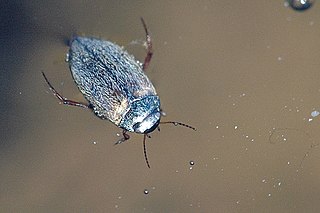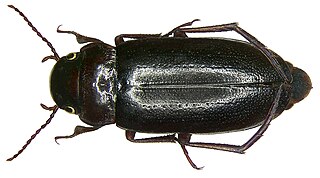Related Research Articles

Beetles are insects that form the order Coleoptera, in the superorder Endopterygota. Their front pair of wings are hardened into wing-cases, elytra, distinguishing them from most other insects. The Coleoptera, with about 400,000 described species, is the largest of all orders, constituting almost 40% of described insects and 25% of all known animal life-forms; new species are discovered frequently, with estimates suggesting that there are between 0.9 and 2.1 million total species. Found in almost every habitat except the sea and the polar regions, they interact with their ecosystems in several ways: beetles often feed on plants and fungi, break down animal and plant debris, and eat other invertebrates. Some species are serious agricultural pests, such as the Colorado potato beetle, while others such as Coccinellidae eat aphids, scale insects, thrips, and other plant-sucking insects that damage crops.

The whirligig beetles are water beetles, comprising the family Gyrinidae that usually swim on the surface of the water if undisturbed, though they swim underwater when threatened. They get their common name from their habit of swimming rapidly in circles when alarmed, and are also notable for their divided eyes which are believed to enable them to see both above and below water. The family includes some 700 extant species worldwide, in 15 genera, plus a few fossil species. Most species are very similar in general appearance, though they vary in size from perhaps 3 mm to 18 mm in length. They tend to be flattened and rounded in cross section, in plain view as seen from above, and in longitudinal section. In fact their shape is a good first approximation to an ellipsoid, with legs and other appendages fitting closely into a streamlined surface. Whirligig beetles belong to the beetle suborder Adephaga, which also includes ground beetles and diving beetles.

The Haliplidae are a family of water beetles that swim using an alternating motion of the legs. They are therefore clumsy in water, and prefer to get around by crawling. The family consists of about 200 species in 5 genera, distributed wherever there is freshwater habitat; it is the only extant member of superfamily Haliploidea. They are also known as crawling water beetles or haliplids.

The Dytiscidae – based on the Greek dytikos (δυτικός), "able to dive" – are the predaceous diving beetles, a family of water beetles. They occur in virtually any freshwater habitat around the world, but a few species live among leaf litter. The adults of most are between 1 and 2.5 cm (0.4–1.0 in) long, though much variation is seen between species. The European Dytiscus latissimus and Brazilian Megadytes ducalis are the largest, reaching up to 4.5 cm (1.8 in) and 4.75 cm (1.9 in) respectively. In contrast, the smallest is likely the Australian Limbodessus atypicali of subterranean waters, which only is about 0.9 mm (0.035 in) long. Most are dark brown, blackish, or dark olive in color with golden highlights in some subfamilies. The larvae are commonly known as water tigers due to their voracious appetite. They have short, but sharp mandibles and immediately upon biting, they deliver digestive enzymes into prey to suck their liquefied remains. The family includes more than 4,000 described species in numerous genera.

Hydraenidae is a family of very small aquatic beetles, sometimes called "Minute moss beetles", with a worldwide distribution. They are around 0.8 to 3.3 mm in length. The adults store air on the underside of the body as well as beneath the elytra which allows them to crawl underwater, often on the underside of the water surface tension, though they cannot swim. Some species have gills that effectively allow them to stay underwater indefinitely. Larvae vary from being fully terrestrial, to being aquatic at least in their earliest instars. The diet of hydraenid larvae and adults is thought to consist of algae, spores and other plant matter. At least some hydraenid adults use stridulation to communicate. There are around 1,300 species in 42 genera.

Rhantus is a genus of beetle in family Dytiscidae. There are about 100 species distributed worldwide. They often live in pools and marshy habitat types. Several species have colonized oceanic islands and become endemics.

Agabus is a large genus of predatory aquatic beetles in the family Dytiscidae, proposed in 1817 by William Elford Leach and named after Agabus, an early follower of Christianity. The adult beetles are moderate-sized, 5 to 14 mm long. The genus is primarily Holarctic in distribution, with only a few species known from the Afrotropical and Neotropical realms. Three species of Agabus, namely A. clypealis, A. discicollis and A. hozgargantae are endangered according to the IUCN Red List. The division into subgenera is not widely accepted. However, a number of species groups are recognized after the works of David J. Larson and Anders N. Nilsson. The genus is probably polyphyletic or paraphyletic. In a recent study of mitochondrial DNA, Agabus was found paraphyletic with respect to several of the species groups of Platambus, a closely related genus in the tribe Agabini. Lately the taxonomy of the genus has been revised, and some groups of species were transferred from Agabussensu stricto to other genera in the tribe Agabini.
Hydrotrupes is a genus of beetles in the family Dytiscidae, containing the following species:

Allodessus is a genus of beetles in the family Dytiscidae, containing the following species:

Liodessus is a genus of beetles in the family Dytiscidae, containing the following species:
Phreatodessus is a genus of beetles in the family Dytiscidae, containing the following species:
Copelatus brivioi is a species of diving beetle. It is part of the genus Copelatus in the subfamily Copelatinae of the family Dytiscidae. It was described by Rocchi in 1976.

Copelatus chevrolati is a species of diving beetle. It is part of the genus Copelatus in the subfamily Copelatinae of the family Dytiscidae. It was described by Aubé in 1838. There are two described subspecies: C. c. chevrolati and C. c. renovatus.
Copelatus takakurai is a species of diving beetle. It is part of the subfamily Copelatinae in the family Dytiscidae. It was described by Satô in 1985.
Copelatus taprobanicus is a species of diving beetle endemic to Sri Lanka. It is part of the genus Copelatus in the subfamily Copelatinae of the family Dytiscidae. It was described by Wewalka & Vazirani in 1985.
Carabdytes plantaris is a naturally uncommon species of diving beetle in the family Dytiscidae. It is endemic to New Zealand. For over a century, it was known from just a single specimen collected in 1880 "near Dunedin", and doubts were cast on whether it was actually a New Zealand species at all. In 1986, it was rediscovered when several were collected from a roadside pond near Lake Ellesmere. Carabdytes plantaris is now classed as "naturally uncommon" by the Department of Conservation.

Hydroporini is a tribe of predaceous diving beetles in the family Dytiscidae. There are at least 730 described species in Hydroporini.

Hydroporinae is a subfamily of predaceous diving beetles in the family Dytiscidae. There are at least 2,200 described species in Hydroporinae.

Colymbetinae is a subfamily of predaceous diving beetles in the family Dytiscidae. There are about 11 genera and at least 130 described species in Colymbetinae.
Laccophilus sharpi, is a species of predaceous diving beetle found in Asia, Africa and Australian region.
References
- ↑ Ordish, R. G. (1976). "Two new genera and species of subterranean water beetle from New Zealand (Coleoptera: Dytiscidae)". New Zealand Journal of Zoology. 3 (1): 1–10. doi: 10.1080/03014223.1976.9517892 . ISSN 0301-4223.
- ↑ Ordish, R. G. (1985). "A Review of Spermothecal Structure in New Zealand Dytiscids". Proceedings of the Academy of Natural Sciences of Philadelphia . 137 (1): 128–131. JSTOR 4064886.
- ↑ Dytiscidae Species List Archived October 23, 2012, at the Wayback Machine at Joel Hallan's Biology Catalog. Texas A&M University. Retrieved on 7 May 2012.